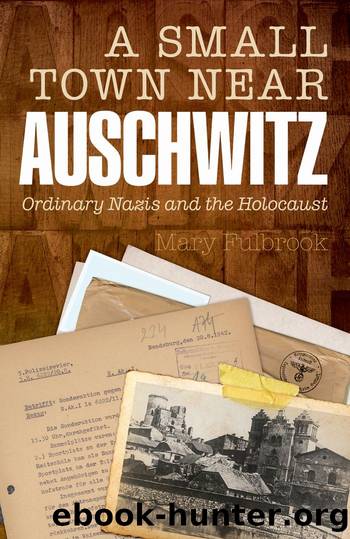A Small Town Near Auschwitz by Mary Fulbrook;

Author:Mary Fulbrook;
Language: eng
Format: epub
Publisher: OUP Premium
Published: 2012-07-15T00:00:00+00:00
Figure 15. An illicit photograph of the April 1942 hanging
It was strictly forbidden to take photographs at this well-orchestrated public event, which some 5,000 Jews were forced to watch for over two hours before they were allowed to return home. This photograph was probably taken by a German civilian.
United States Holocaust Memorial Museum, courtesy of the Żydowski Instytut Historyczny.
It required the permission of the civilian authorities to ensure that the regular restrictions on Jewsâ movements would be lifted in order to ensure the maximum audiences and the âdesired effectsâ.
Was there a particular significance to these two simultaneous spectacles? Public hangings appear to have taken place over a wide range of different locations at around the same time, about one month before major deportations, and planned with similar care some days in advance. There are many eyewitness testimonies to this effect, as, for example, in the neighbouring district of Chrzanów, where, according to one report: âRepresentatives of the German authorities with their wives and friends assembled at the execution site. They were laughing while the persons condemned to death were the object of ridicule.â58 These coordinated public spectacles of mass hangings do not seem, as in other cases of retributions, to have been in direct response to a particular crime; it seems there was a policy of âany Jew will doâ, although infringements of German rules (including not only black market dealings but also very trivial âoffencesâ) were adduced as the ostensible âreasonâ for these executions. Members of the Kattowitz Gestapo, including Hans Dreier as the official responsible for Jewish affairs, seem to have been heavily involved in the organization and implementation of the spectacles, examining the sites in advance and making arrangements for setting up the gallows, in the process no doubt liaising closely with local officials.
In the case of a small town in the Reichsgau Wartheland, we have the contemporary evidence of the local mayor and Amtskommissar, Alexander Hohenstein.59 Hohenstein recalls in painful detail the way in which he was visited by two members of the SS several days before the intended hanging, and requested to find a sixth person for the gallows. It was not as if the gallows were already in existence: they were to be specially constructed to accommodate a half dozen Jews, and the SS informed him that they were prepared to supply only five of them, local Jews who had in the meantime been incarcerated in Åódź. He was to find the sixth. On protesting against this, he was told that all Jews were criminals, and anyone could be used for the occasion; whether or not he could identify someone who had actually committed a crime and deserved to be punished for a specific offence, they were all fit to be put to death in any case. Following several days of agonized thought and even discussion with the local Leader of the Jewish Council, Hohenstein refused to find a sixth victim; on the designated day of the hanging, that part of the gallows remained empty.
Download
This site does not store any files on its server. We only index and link to content provided by other sites. Please contact the content providers to delete copyright contents if any and email us, we'll remove relevant links or contents immediately.
Room 212 by Kate Stewart(4130)
The Crown by Robert Lacey(4123)
Endurance: Shackleton's Incredible Voyage by Alfred Lansing(3864)
The Iron Duke by The Iron Duke(3661)
The Rape of Nanking by Iris Chang(3539)
Killing England by Bill O'Reilly(3471)
Joan of Arc by Mary Gordon(3279)
Say Nothing by Patrick Radden Keefe(3084)
I'll Give You the Sun by Jandy Nelson(2853)
Shadow of Night by Deborah Harkness(2756)
Hitler's Monsters by Eric Kurlander(2744)
Margaret Thatcher: The Autobiography by Thatcher Margaret(2694)
Mary, Queen of Scots, and the Murder of Lord Darnley by Alison Weir(2685)
Darkest Hour by Anthony McCarten(2658)
Blood and Sand by Alex Von Tunzelmann(2618)
Red Famine: Stalin's War on Ukraine by Anne Applebaum(2476)
Eleanor & Park by Rainbow Rowell(2406)
The One Memory of Flora Banks by Emily Barr(2360)
Book of Life by Deborah Harkness(2291)
